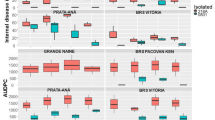Abstract
The aim of this study was to assess the biocontrol capacity of rev157, a non-pathogenic mutant of a pathogenic strain of Fusarium oxysporum f. sp. melonis (Fom24). Inoculated in association with the virulent parental strain, the mutant rev157 did not protect the host plant (muskmelon) against infection by Fom24. Applied on flax, a non-host plant, the mutant rev157 was not able to protect it against its specific pathogen F. oxysporum f. sp. lini. On the contrary the parental strain Fom24 did protect flax as well as a soil-borne biocontrol strain (Fo47). Since the mutant rev157 was affected neither in its growth in vitro nor in its capacity to penetrate into the roots, it can be speculated that the mutation has affected traits responsible for interactions within the plant. In F. oxysporum the pair of strains Fom24/rev157 is a good candidate to identify genes involved in the biocontrol capacity of F. oxysporum and to test the hypothesis of a link between capacity to induce the disease and capacity to induce resistance in the plant.



Similar content being viewed by others
References
Alabouvette, C., Lemanceau, P., & Steinberg, C. (1993). Recent advances in the biological control of Fusarium wilts. Pesticide Science, 37, 365–373.
Alabouvette, C., Olivain, C., L’Haridon, F., Aime, S., & Steinberg, C. (2007). Using strains of Fusarium oxysporum to control Fusarium wilts: dream or reality? In Vurro, M., & Gressel, J. (Eds.), Novel biotechnologies for biocontrol agent enhancement and management (pp.157–177). NATO-ASI series, Springer.
Benhamou, N., & Garand, C. (2001). Cytological analysis of defense-related mechanisms induced in pea root tissues in response to colonization by nonpathogenic Fusarium oxysporum Fo47. Phytopathology, 91, 730–740.
Biles, C. J., & Martyn, R. D. (1989). Local and systemic resistance induced in watermelons by formae speciales of Fusarium oxysporum. Phytopathology, 79, 856–860.
Correll, J. C., Klittich, C. J. R., & Leslie, J. R. (1987). Nitrate nonutilizing mutants of Fusarium oxysporum and their use in vegetative compatibility tests. Phytopathology, 77, 1640–1646.
Fravel, D., Olivain, C., & Alabouvette, C. (2003). Fusarium oxysporum and its biocontrol. The New Phytologist, 157, 493–502.
Freeman, S., & Rodriguez, R. J. (1993). Genetic conversion of a fungal plant pathogen to a nonpathogenic, endophytic mutualist. Science, 260, 75–78.
Freeman, S., Zveibil, A., Vintal, H., & Maymon, M. (2002). Isolation of nonpathogenic mutants of Fusarium oxysporum f. sp. melonis for biological control of Fusarium wilt in cucurbits. Phytopathology, 92, 164–168.
Fuchs, J. G., Moënne-Loccoz, Y., & Défago, G. (1997). Nonpathogenic Fusarium oxysporum strain Fo47 induces resistance to Fusarium wilt in tomato. Plant Disease, 81, 492–496.
Huertas-González, M. D., Ruiz-Roldán, M. C., Di Pietro, A., & Roncero, M. I. G. (1999). Cross protection provides evidence for race-specific avirulence factors in Fusarium oxysporum. Physiological and Molecular Plant Patholology, 54, 63–72.
Kroon, B. A. M., Scheffer, R. J., & Elgersma, D. M. (1991). Induced resistance in tomato plants against Fusarium wilt invoked by Fusarium oxysporum f. sp. dianthi. Netherlands Journal of Plant Pathology, 97, 401–408.
Larkin, R. P., & Fravel, D. R. (1999). Mechanims of action and dose-response relationships governing biological control of Fusarium wilt of tomato by nonpathogenic Fusarium spp. Phytopathology, 89, 1152–1161.
Mas, P., Risser, G., & Rode, J. C. (1969). Phénomènes de prémunition entre formes spécialisées ou races de Fusarium oxysporum chez Cucumis melo. Annales de Phytopathologie, HS, 1, 213–216.
Matta, A. (1966). Effeto immunizzante di alcuni micromiceti verso le infezioni di Fusarium oxysporum f. sp. lycopersici su pomodoro. Annali Facoltà di Agraria Università di Turino, 3, 85–98.
Matta, A. (1971). Microbial penetration and immunization of uncongenial host plants. Annual Review of Phytopathology, 9, 387–410.
Migehli, Q., Steinberg, C., Davière, P. M., Olivain, C., Gerlinger, C., Gautheron, N., Alabouvette, C., & Daboussi, M. J. (2000). Recovery of mutants impaired in pathogenicity after transposition of impala in Fusarium oxysporum f. sp. melonis. Phytopathology, 90, 1279–1284.
Olivain, C., & Alabouvette, C. (1997). Colonization of tomato root by a nonpathogenic strain of Fusarium oxysporum. The New Phytologist, 137, 481–494.
Olivain, C., Steinberg, C., & Alabouvette, C. (1995). Evidence of induced resistance in tomato inoculated by non-pathogenic strains of Fusarium oxysporum. In Manka, M. (Ed.), Environmental biotic factors in integrated plant diseases control (pp. 427–430). Poland: The Polish Phytopathological Society Poznan.
Olivain, C., Trouvelot, S., Binet, M. N., Cordier, C., Pugin, A., & Alabouvette, C. (2003). Colonization of flax roots and early physiological responses of flax cells inoculated with pathogenic and non-pathogenic strains of Fusarium oxysporum. Applied and Environmental Microbiology, 69, 5453–5462.
Redman, R. S., Freeman, S., Clifton, D. R., Morrel, J., Brown, G., & Rodriguez, R. J. (1999). Biochemical analysis of plant protection afforded by a nonpathogenic endophytic mutant of Colletotrichum magna. Plant Physiology, 119, 705–804.
Van Loon, L. C. (2000). Systemic induced resistance. In Slusarenko, A. J., Fraser, R. S. S., & Van Loon, J. C. (Eds.), Mechanisms of Resistance to Plant Diseases (pp. 521–574). Dordrecht, NL: Kluwer Academic publishers.
Wymore, L. A., & Baker, R. (1982). Factors affecting cross-protection in control of Fusarium wilt of tomato. Plant Disease, 66, 90–910.
Acknowledgements
We thank A.M. Tronsmo for helpful discussions and D. Pouhair for help in the greenhouse. This work was supported by the European Project 2E-BCAs in Crops (Food-CT-2003-001687). The content of this publication is the sole responsibility of its authors and in no way represents the view of the Commission or its services or anticipates its policy in this area.
Author information
Authors and Affiliations
Corresponding author
Rights and permissions
About this article
Cite this article
L’Haridon, F., Aimé, S., Alabouvette, C. et al. Lack of biocontrol capacity in a non-pathogenic mutant of Fusarium oxysporum f. sp. melonis . Eur J Plant Pathol 118, 239–246 (2007). https://doi.org/10.1007/s10658-007-9139-3
Received:
Accepted:
Published:
Issue Date:
DOI: https://doi.org/10.1007/s10658-007-9139-3




